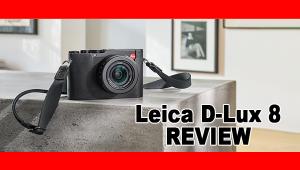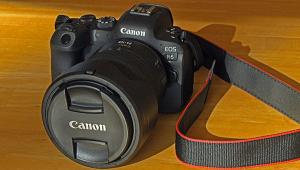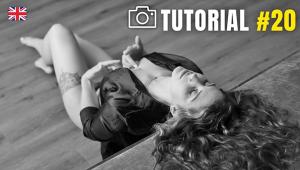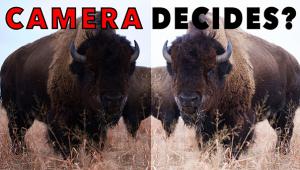Panasonic’s Lumix DMC-L1; High-Tech Digital SLR With Conventional Controls And Traditional Style Page 2
Live View Mode
Because it was previously available with the EVOLT E-330, this feature is already well-known but the Panasonic system is quite different, as detailed in our sidebar chart. The DMC-L1 provides a single Live View mode that allows for full-time preview of a scene on the 2.5" LCD monitor, with 100 percent coverage. Press the pertinent button and the camera automatically flips the reflex mirror out of the sensor's light path. Once that obstruction is removed, light can strike the Live MOS sensor. The image data that's captured is directed to the LCD monitor for a crisp, smooth preview. Because the reflex mirror is locked in the "up" position, internal vibration is minimized, useful in high-magnification photography with compatible macro lenses. (At high magnification, the effects of any vibration are amplified, increasing the risk of some blurring. For the same reason, it's important to use a rigid tripod.)
 |
 |
|
 |
 |
|
|
||
Autofocus is available but the camera must lower and raise the reflex mirror for the system to work; that process, and the noisy clicking it produces, can be somewhat slow and annoying. Frankly, I found manual focus to be far more convenient. The ability to select up to 10x preview magnification was valuable, making it easy to achieve maximum focus accuracy. Live View worked best in bright light; in darker locations, the LCD image became dimmer, too, making it more difficult to compose and focus.
Evaluation: Live View is not as simple and quick as it is with compact digicams, but it is a convenient feature especially for subjects such as architecture, landscapes, and for extreme close-ups of nature subjects or small objects. Note, too, that the Live View image is accurate in representing the changes produced by any exposure compensation or white balance adjustment. Depth of field preview (for evaluating the range of acceptably sharp focus) is also available at any f/stop, at the touch of a button. The preview image on the LCD screen darkens at small apertures, a familiar aspect with any type of depth of field preview system. The advanced Live View features may not be relevant to those who simply want to compose using the LCD screen but should certainly appeal to serious photographers.
Performance And Image Quality
During the test period, I made hundreds of images and found the Lumix DMC-L1 to be a very competent performer. It was fast in all respects and provided incredible burst depth thanks to the new Venus Engine III LSI processor. With a high-speed Panasonic SDHC card, I was able to keep shooting large/superfine JPEGs until the card was full. Autofocus was reliable even in low light and the continuous tracking focus provided a high percentage of sharply focused images of moving subjects. The 3 fps (frames per second) rate was fast enough for me although serious sports photographers might want an even faster framing rate.
I began by shooting with multi-zone metering, AWB (Auto White Balance), and Standard "Film Mode": for a default level for contrast, sharpness, and color saturation. The images exhibit fairly rich but believable colors, a wide tonal range for very good highlight and shadow detail, and moderate sharpness, easily boosted if desired with the sharpening utilities in Adobe's Photoshop or other programs. On sunny days, some slight overexposure (up to a half stop) was common, but that was easy to prevent with exposure compensation. The AWB system proved to be very reliable except under artificial lighting; in such conditions, some of the many white balance overrides were certainly useful.
The DMC-L1 provides a wealth of other "Film Modes," varying the level of color saturation, sharpness, and contrast depending on the mode selected. The options include Standard, Dynamic, Nature, and Smooth plus three Black and White modes: Standard, Dynamic, and Smooth. Each mode produces an entirely different effect that may be suitable for a certain type of subject or lighting condition, or merely to satisfy a photographer's own specific preferences. While I generally used the Standard color and black and white options, I found the Smooth modes to be useful as well; the lower contrast was ideal under harsh lighting conditions. Two "My Film" modes are also available, allowing the user to set a desired level for color saturation, sharpness, contrast, and high ISO Noise Reduction. This function is certainly valuable when shooting JPEGs but unnecessary in raw capture because all parameters can be adjusted as desired using the versatile SILKYPIX Developer Studio 2.0 converter.
Evaluation: My large/superfine JPEGs made at ISO 100-400 are excellent, with high edge-to-edge resolution thanks to the Leica lens and the Panasonic technologies. After re-sizing and optimizing them for printing (at 240dpi) in Photoshop CS2, I was able to make beautiful 13x17" inkjet outputs. Raw captures (after conversion to TIFF) exhibit an even greater level of detail. While the best 10-megapixel D-SLR cameras are more suitable for those who want to make (or order) even larger prints, the 7.4-megapixel resolution should be plenty for most photo enthusiasts.
Images made at ISO 800 are quite clean and very sharp, with a fine, tight "grain" pattern that does not obliterate intricate details. By ISO 1600, an infrequently used level, some mottled colored specks (chroma noise) are obvious but the photos are still sharp and quite finely detailed, suitable for good 8.5x11" prints. What's most impressive is the superior digital noise control provided by the Venus Engine III LSI processor; the system works its magic without producing obvious blurring of the image.
Conclusion
Because the Lumix D-SLR is sold only in a kit that includes the Leica D lens with Image Stabilizer, the package is relatively expensive ($1999, street price). That may provide a measure of exclusivity; you'll never see as many DMC-L1's as Digital Rebel-series cameras, for example. Aside from price, styling sets this Panasonic model apart from all of its competitors. Friends in the under 30 age category unanimously agreed that "it looks old-fashioned." Others, in the over 40 group, considered the camera and Leica lens to be more desirable than models that "seem plasticky" or "look the same." Several said they would be willing to pay extra for the kit, particularly because of the lens.
Panasonic does not view their first D-SLR as a mass-market product. Still, as additional lenses become available, the DMC-L1 should become a strong contender in its intended niche. According to a company rep, the camera and Leica zoom target those who loved photography with conventional 35mm equipment and now want a D-SLR with a traditional look, feel, and operation. If those attributes are important to you, and if you want fine image quality plus great speed, versatility, and a superior lens, this may just be the right package for you.
Sidebar
|
Comparison: Lumix DMC-L1 Vs. Olympus EVOLT E-330
|
||
| As mentioned in the text, the Panasonic and Olympus cameras share some technology and components, but they're also quite different in controls, operating sequences, features, and some performance aspects. For example, Panasonic intentionally omitted the subject-specific Program modes and added new amenities such as modes that simulate the effects of different types of color and monochrome films. Like the conventional controls, the "Film Modes" are likely to be considered most logical and intuitive by long-time photographers who previously used 35mm SLR or rangefinder cameras. The following chart lists the most significant differences between the Panasonic and Olympus models. | ||
|
Feature
|
EVOLT E-330
|
Lumix DMC-L1
|
|
|
 |
 |
| Construction, Size, Weight | Metal sub frame; 5.5x3.4x2.8"; 19.4 oz | f/3.5-5.6 AL zoom back and top; 5.7x3.4x3.0"; 18.7 oz |
| Capture Formats | Numerous JPEG options, raw, TIFF, and raw+JPEG | Fewer JPEG options plus raw capture |
| Built-In Flash | Conventional for direct flash | Dual angle, also allows for bounce flash |
| Live View (Employing A Secondary Sensor) | Yes; with 92 percent frame coverage; Live View boost for brighter image | Not available |
| Live View (Employing Live MOS Sensor, With 100 Percent exposure Frame Coverage) | "Macro" mode with 100 percent field of view; manual focus with magnification if desired; AF with Firmware Version 1.2 or later | Similar "Full Time" mode, but with accurate representation of compensation and white balance adjustments; depth of field preview on LCD monitor is available; 16:9 and 3:2 formats also selectable |
| LCD Screen | Articulated; allows for setting | Fixed |
| Processor | various positions TruePic Turbo "micro-smoothes individual pixels for finer, brighter results" | High-speed Venus Engine III LSI with distinct control of luminance noise and chromatic noise |
| Burst Depth | Up to four largest/finest JPEGs or raw captures in a sequence | Unlimited number of largest/finest JPEGs until (fast) SD card is full or six raw captures |
| Image Parameter Adjustments | User selectable levels for saturation, contrast, sharpness; various monochrome effects "filters"; Natural Vivid, and Muted Color modes | Selectable "Film Modes" that automatically vary color, contrast, and sharpness; also, two modes with user-selectable levels for each parameter |
| Metering Options | Spot, 49-zone Digital ESP, center-weighted, highlight-based spot and shadow-based spot | Similar; omits extra spot metering options but employs 256-zone metering in Live View |
| Extra Features | Conventional depth of field preview; wider range of exposure compensation; more Playback options; in camera redeye fix software | 2x or 4x digital zoom and extra Optical Zoom in lower resolution capture |
| Compatible Memory Cards | CompactFlash and xD-Picture Card | MMC, SD, and (new "high-speed") SDHC |
| Average Street Price (Kit) At Press Time | $1099, with Zuiko Digital 14-45mm f/3.5-5.6 AL zoom | $1999, with Leica D 14-50mm f/2.8-3.5 ASPH (MEGA OIS) zoom; price may drop after longer term availability |
For a full list of Technical Specifications, visit the Instant Links section of our website at: www.shutterbug.com/currentissuelinks/
For more information, contact Panasonic, One Panasonic Way, Secaucus, NJ 07094; (800) 211-7262; www.panasonic.com.
A long-time "Shutterbug" contributor, stock photographer Peter K. Burian (www.peterkburian.com) is the author of several books, including the new "Magic Lantern Guide to the Sony Alpha A100" (Lark Books) and "Mastering Digital Photography and Imaging" (Sybex). He is also a digital photography course instructor with BetterPhoto.com.
- Log in or register to post comments

















































